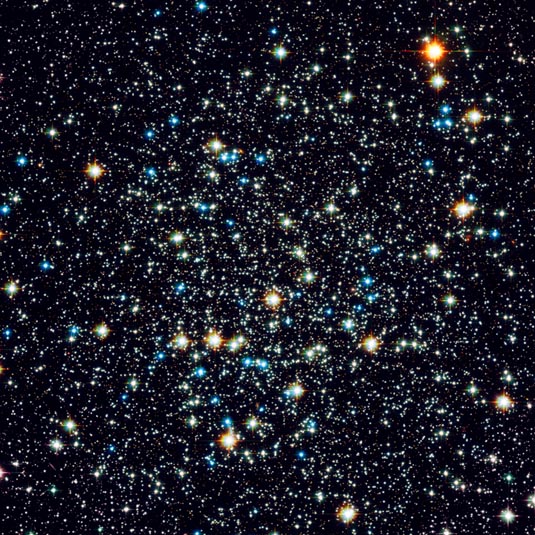
Description: Globular Star Clusters
Position (J2000): RA 00hr 52m 45.24s Dec -26° 34' 57.4"
Constellation: Sculptor
Distance: 30,000 light years
Visual Magnitude: 9.4
Apparent Dimensions: 13.8'
Field of View: 3.2 arc-minutes
Image Credit: ESA/Hubble & NASA
Release date: March 14, 2011
ABOUT THIS IMAGE:
Most of the rich globular star clusters that orbit the Milky Way have cores that are tightly packed with stars, but NGC 288 is one of a minority of low-concentration globulars, with its stars more loosely bound together. This new image from the Advanced Camera for Surveys on the NASA/ESA Hubble Space Telescope completely resolves the old stars at the core of the cluster.
The color and brightness of the stars in the picture tell the story of how the stars have evolved in the cluster. The many fainter points of light are normal low-mass stars that are still fusing hydrogen in the same way as the Sun. The brighter stars fall into two classes: the yellow ones are red giant stars that are at a later phase in their careers and are now bigger, cooler and brighter. The bright blue stars are even more massive stars that have left the red giant phase and are being powered by helium fusion in their cores.
The stars within globular clusters form at about the same time from the same cloud of gas, making these close families of stars. However, astronomers think that the stellar siblings in low-concentration globular clusters such as NGC 288, which are not so tightly bound together by gravity as richer and denser clusters, may eventually disperse and go their separate ways.
NGC 288 is found within the rather obscure southern constellation of Sculptor, at a distance of about 30 000 light-years. This constellation also contains NGC 253, more commonly called the Sculptor Galaxy due to its location, and these two deep sky objects are close enough together on the sky to be observed in the same binocular field of view. William Herschel first spotted NGC 288 in 1785 and also recognized that it was a globular cluster that could be resolved into stars in his telescope.
This
picture was created from Hubble images taken using the Wide Field Channel
of the Advanced Camera for Surveys through four different filters:
Band Color Wavelength Exposure
time
Optical Blue
435 nm 740
s
Optical Green
606 nm 530
s
Optical (H-alpha) Orange
658 nm 1760
s
Infrared
Red
814 nm 610
s